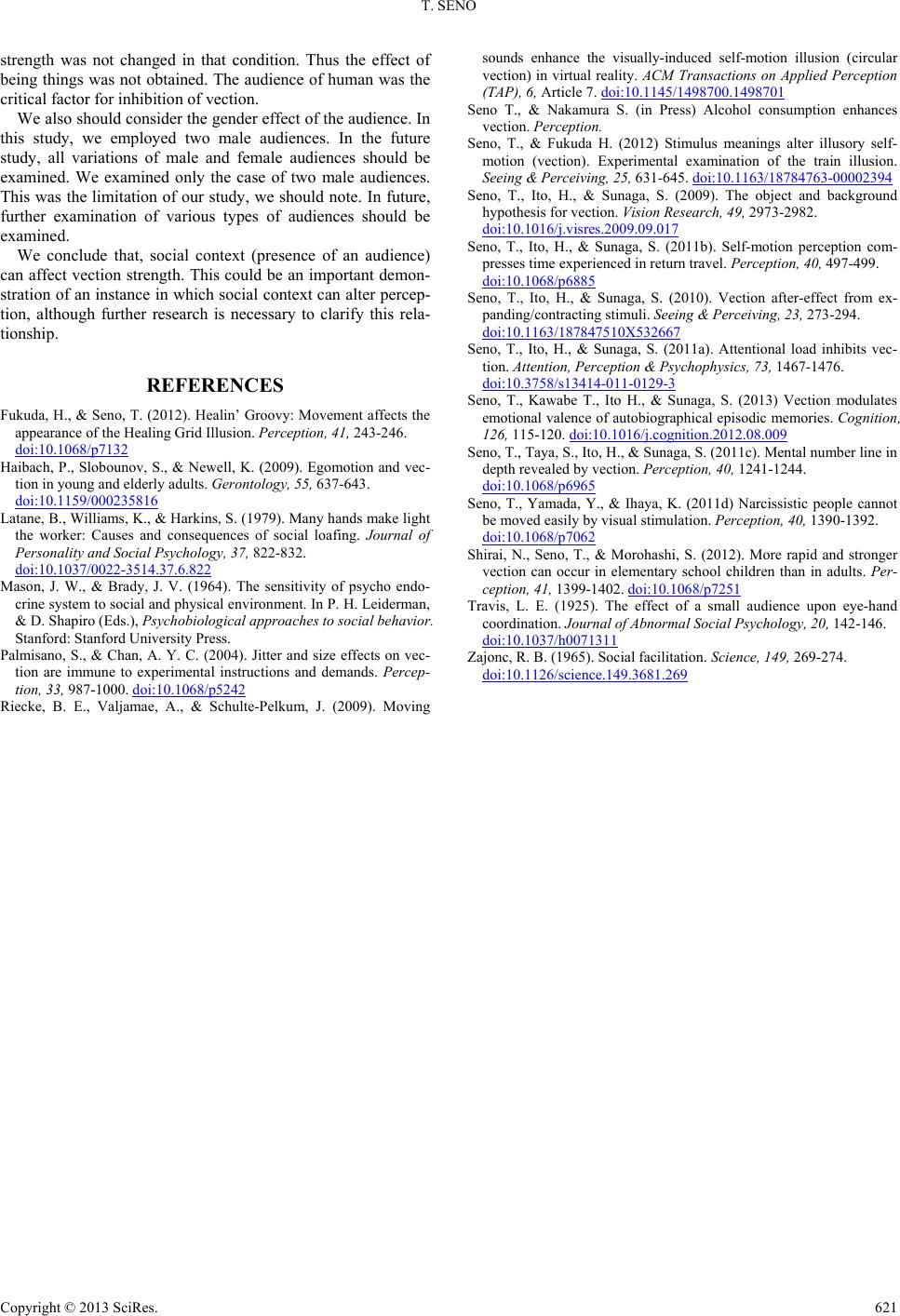
T. SENO
Copyright © 2013 SciRes. 621
strength was not changed in that condition. Thus the effect of
being things was not obtained. The audience of human was the
critical factor for inhibition of vection.
We also should consider the gender effect of the audience. In
this study, we employed two male audiences. In the future
study, all variations of male and female audiences should be
examined. We examined only the case of two male audiences.
This was the limitation of our study, we should note. In future,
further examination of various types of audiences should be
examined.
We conclude that, social context (presence of an audience)
can affect vection strength. This could be an important demon-
stration of an instance in which social context can alter percep-
tion, although further research is necessary to clarify this rela-
tionship.
REFERENCES
Fukuda, H., & Seno, T. (2012). Healin’ Groovy: Movement affects the
appearance of the Healing Grid Illusion. P erception, 41, 243-246.
doi:10.1068/p7132
Haibach, P., Slobounov, S., & Newell, K. (2009). Egomotion and vec-
tion in young and elderly adults. Gerontology, 55, 637-643.
doi:10.1159/000235816
Latane, B., Williams, K., & Harkins, S. (1979). Many hands make light
the worker: Causes and consequences of social loafing. Journal of
Personality and Social Psychology, 37, 822-832.
doi:10.1037/0022-3514.37.6.822
Mason, J. W., & Brady, J. V. (1964). The sensitivity of psycho endo-
crine system to social and physical environ ment. In P. H. Leiderman,
& D. Shapiro (Eds.), Psychob io lo g ic al ap pr oaches to social behavior.
Stanford: Stanford University Press.
Palmisano, S., & Chan, A. Y. C. (2004). Jitter and size effects on vec-
tion are immune to experimental instructions and demands. Percep-
tion, 33, 987-1000. doi:10.1068/p5242
Riecke, B. E., Valjamae, A., & Schulte-Pelkum, J. (2009). Moving
sounds enhance the visually-induced self-motion illusion (circular
vection) in virtual reality. ACM Transactions on Applied Perception
(TAP), 6, Article 7. doi:10.1145/1498700.1498701
Seno T., & Nakamura S. (in Press) Alcohol consumption enhances
vection. Perception.
Seno, T., & Fukuda H. (2012) Stimulus meanings alter illusory self-
motion (vection). Experimental examination of the train illusion.
Seeing & Perceiving, 25, 631-645. doi:10.1163/18784763-00002394
Seno, T., Ito, H., & Sunaga, S. (2009). The object and background
hypothesis for vection. Vi sion Research, 49, 2973-2982.
doi:10.1016/j.visres.2009.09.017
Seno, T., Ito, H., & Sunaga, S. (2011b). Self-motion perception com-
presses time experienced in return travel. Perception, 40, 497-499.
doi:10.1068/p6885
Seno, T., Ito, H., & Sunaga, S. (2010). Vection after-effect from ex-
panding/contracting stimuli. Seeing & Perceiving, 23, 273-294.
doi:10.1163/187847510X532667
Seno, T., Ito, H., & Sunaga, S. (2011a). Attentional load inhibits vec-
tion. Attention, Perception & Psychophysics, 73, 1467-1476.
doi:10.3758/s13414-011-0129-3
Seno, T., Kawabe T., Ito H., & Sunaga, S. (2013) Vection modulates
emotional valence of autobiographical episodic memories. Cognition,
126, 115-120. doi:10.1016/j.cognition.2012.08.009
Seno, T., Taya, S., Ito, H., & Sunaga, S. (2011c). Mental number line in
depth revealed by vection. Perception, 40, 1241-1244.
doi:10.1068/p6965
Seno, T., Yamada, Y., & Ihaya, K. (2011d) Narcissistic people cannot
be moved easily by visual stimulation. Perception, 40, 1390-1392.
doi:10.1068/p7062
Shirai, N., Seno, T., & Morohashi, S. (2012). More rapid and stronger
vection can occur in elementary school children than in adults. Per-
ception, 41, 1399-1402. doi:10.1068/p7251
Travis, L. E. (1925). The effect of a small audience upon eye-hand
coordination. Jour na l o f Abnormal Social Psychology, 20, 142-146.
doi:10.1037/h0071311
Zajonc, R. B. (1965). Social facilitation. Science, 149, 269-274.
doi:10.1126/science.149.3681.269